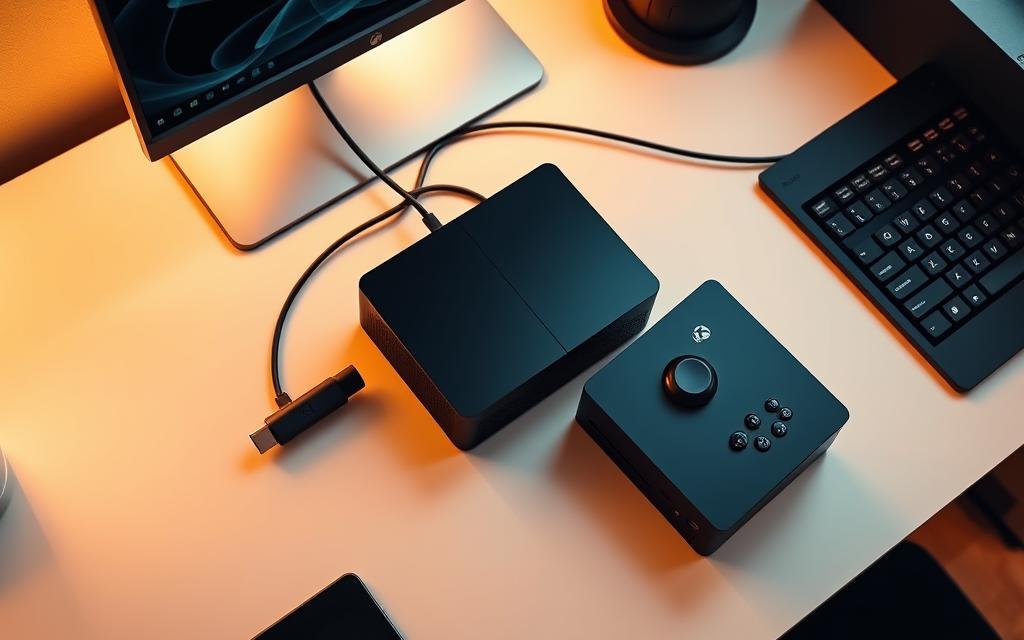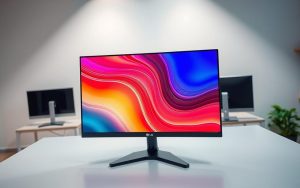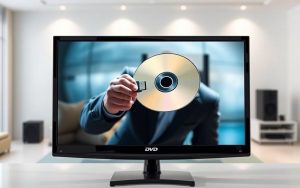Table of Contents
Modern gaming has evolved, offering players more flexibility than ever. One popular trend is using a laptop as a display for your Xbox console. This setup not only saves space but also enhances portability, making it ideal for gamers on the go.
Setting up your laptop HDMI connection is straightforward. With just a few steps, you can enjoy a seamless gaming experience directly on your laptop screen. This method eliminates the need for additional monitors, making it a practical solution for small spaces.
This article will guide you through the entire process, from initial setup to optimizing performance. Whether you’re a casual gamer or a competitive player, understanding this setup can elevate your gameplay. Stay tuned to learn more about compatibility requirements and performance tips for different Xbox models.
What You Need to Connect Xbox to PC with HDMI
A seamless gaming setup starts with understanding your hardware requirements. Ensuring you have the right tools and compatible devices is crucial for a smooth experience. Let’s break down the essentials.
Essential Hardware: HDMI Cable and Ports
The backbone of this setup is a high-quality HDMI cable. For optimal performance, especially with 4K or 120Hz displays, a high-speed HDMI 2.0 or 2.1 cable is recommended. These cables ensure minimal lag and maximum clarity.
Next, verify the HDMI input port on your laptop. Most modern laptops feature HDMI ports, but it’s essential to distinguish between input and output ports. An input port is necessary to receive the signal from your Xbox. If your laptop lacks an HDMI input, consider using a USB 3.0 adapter.
Checking Laptop Compatibility
Not all laptops support HDMI input, so compatibility checks are vital. Start by inspecting your laptop’s ports. Look for labels like “HDMI-in” or consult the manufacturer’s website for detailed specifications.
For older models or USB-C laptops, adapters may be required. Additionally, ensure your Xbox model’s output aligns with your laptop’s capabilities. For example, the Xbox Series X supports 4K, so your laptop’s HDMI input port must handle this resolution.
Finally, avoid using HDMI splitters, as they can degrade signal quality. Stick to direct connections for the best results. For more details on compatibility, check this guide on HDMI input port setups.
How to Connect Xbox to PC with HDMI
Setting up your gaming devices correctly ensures a smooth and enjoyable experience. Follow these steps to establish a reliable connection and optimize your display for gaming.
Step 1: Power Off Both Devices
Before starting, ensure both your Xbox and laptop are powered off. This prevents potential electrical issues and ensures a safe setup. Always shut down your devices properly to avoid data corruption or hardware damage.
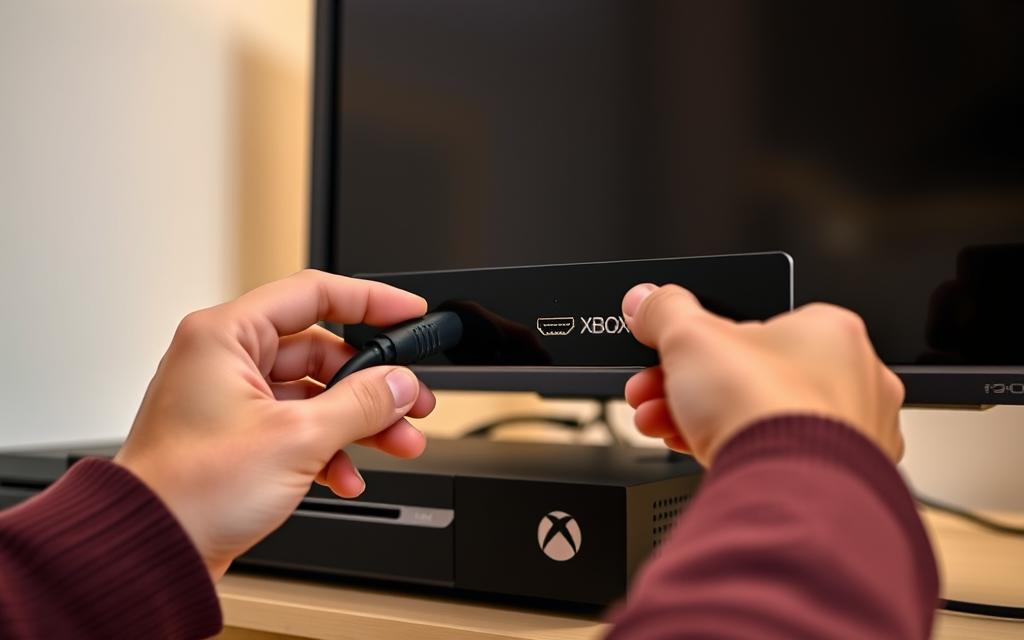
Step 2: Connect the HDMI Cable
Take one end hdmi cable and plug it into the HDMI output port on your Xbox. Insert the other end into the HDMI input port on your laptop. Ensure the cable is securely connected to avoid signal interruptions.
If your laptop lacks an HDMI input, consider using a USB 3.0 adapter. This setup ensures compatibility and maintains signal quality.
Step 3: Configure Display Settings
Once connected, power on both devices. On your laptop, press Windows+P to open the display settings. Select the appropriate input source to match your Xbox’s output.
Navigate to your Xbox dashboard and go to Profile & System > Settings. Adjust the resolution and refresh rate to match your laptop’s capabilities. For initial setup, a 1080p resolution is recommended for compatibility.
“Matching resolutions and refresh rates ensures a seamless gaming experience without visual artifacts.”
If the display isn’t detected, double-check the cable connections and ensure both devices are powered on. Troubleshooting these steps can resolve most initial connection issues.
Adjusting Xbox Display Settings for Optimal Performance
Optimizing your gaming visuals starts with fine-tuning display settings. Proper configuration ensures smooth gameplay and enhances your overall experience. Let’s explore how to adjust resolution, refresh rate, and enable Game Mode for the best results.
Setting the Right Resolution and Refresh Rate
Resolution and refresh rate are critical for a seamless gaming experience. Higher resolutions, like 4K, offer sharper visuals, while a higher refresh rate reduces motion blur. Match these settings to your gaming monitor capabilities for optimal performance.
To adjust these settings, navigate to Profile & System > Settings > General > TV & Display Options. Here, you can select the resolution and refresh rate that suits your setup. For example, a 120Hz refresh rate requires an HDMI 2.1 cable and compatible hardware.
- Resolution-to-screen-size ratio: Higher pixel density delivers crisper visuals.
- VSync and variable refresh rate: These technologies reduce screen tearing and stuttering.
- 60Hz vs 120Hz: A higher refresh rate provides smoother motion but requires powerful hardware.
Enabling Game Mode on Your Laptop
Game Mode optimizes your laptop’s performance by reducing background processes. This ensures more resources are dedicated to your game, improving frame rates and reducing lag.
To activate Game Mode:
- Press the Windows key and type “Settings.”
- Select Gaming from the options.
- Toggle the Game Mode switch to On.
Additionally, configure HDR settings for enhanced contrast and color accuracy. Navigate to Display settings > Windows HD Color and toggle the Use HDR option. Ensure your gaming monitor supports HDR for the best results.
| Setting | Impact | Recommendation |
|---|---|---|
| Resolution | Determines image sharpness | Match to monitor’s native resolution |
| Refresh Rate | Affects motion smoothness | Use 120Hz for competitive gaming |
| Game Mode | Optimizes system performance | Enable for reduced input lag |
“Fine-tuning display settings ensures a seamless and immersive gaming experience.”
By adjusting these settings, you can maximize your gaming performance and enjoy a visually stunning experience. Experiment with different configurations to find the perfect balance for your setup.
Using Your Laptop as an Xbox Monitor
Transforming your laptop into a gaming monitor opens up new possibilities for flexibility and convenience. This setup allows you to use laptop monitor capabilities without investing in additional screens. Whether you’re gaming in a small space or need a portable solution, this method is both practical and efficient.
Switching Input Sources on Your Laptop
To use laptop monitor for gaming, you’ll need to switch the input source. Most laptops require specific key combinations to access the input menu. For example, Dell laptops often use Fn + F8, while HP models may use Fn + F4. Lenovo laptops typically feature a dedicated input button.
If your laptop doesn’t respond, check the BIOS settings. Some systems allow you to configure display preferences at the BIOS level. Ensure the input source matches the connected device for seamless functionality.
Troubleshooting Display Detection Issues
Sometimes, the monitor may fail to detect the signal. Common causes include loose cables, incorrect input settings, or outdated drivers. Start by verifying the cable connections and ensuring the correct input source is selected.
If the issue persists, consider these steps:
- Update your graphics drivers to the latest version.
- Check for HDCP compliance, as incompatible devices can cause handshake errors.
- Test with a different cable or port to rule out hardware issues.
For persistent problems, a cold reboot or firmware update may resolve the issue. Always follow the manufacturer’s guidelines for updates to avoid complications.
“Proper input configuration and troubleshooting can eliminate most display detection problems, ensuring a smooth gaming experience.”
Enhancing Your Gaming Experience
Taking your gaming to the next level involves more than just visuals; audio and responsiveness play a crucial role. Whether you’re immersed in a story-driven adventure or competing in fast-paced matches, optimizing these elements can significantly elevate your gaming experience.

Optimizing Audio for Immersive Play
Sound quality is a game-changer for immersion. Built-in speakers are convenient but often lack depth. For a richer audio experience, consider external solutions like soundbars or gaming headsets. These options deliver clearer treble and deeper bass, enhancing every gaming session.
Surround sound virtualization software, such as Dolby Atmos or Windows Sonic, can further enhance your setup. These tools simulate multi-channel audio, making it feel like sounds are coming from all directions. Pair this with game-specific audio presets for tailored soundscapes that match the game’s atmosphere.
“High-quality audio transforms gameplay, making every detail more vivid and immersive.”
Reducing Input Lag for Competitive Gaming
Input lag can make or break your performance in competitive xbox gaming. To minimize delays, start by optimizing your system. Update drivers, close background apps, and ensure your hardware is running at peak power.
Wired connections for controllers and peripherals reduce latency compared to wireless options. Additionally, enabling features like Game Mode on your monitor or TV can cut processing time, ensuring faster response rates. For the best results, use low-latency peripherals designed for gaming.
- Wired Controllers: Direct connections eliminate wireless interference.
- High Refresh Rate Monitors: Smoother visuals and quicker response times.
- Network Prioritization: Prioritize gaming traffic for cloud-based sessions.
By fine-tuning these settings, you can enjoy a more responsive and enjoyable gaming experience.
Alternative Methods: Streaming Xbox to PC
Streaming your Xbox to a PC offers flexibility beyond traditional setups. Whether you prefer wireless play or remote access, these methods provide seamless gaming experiences without the need for HDMI cables. Let’s explore the tools and techniques to make this possible.
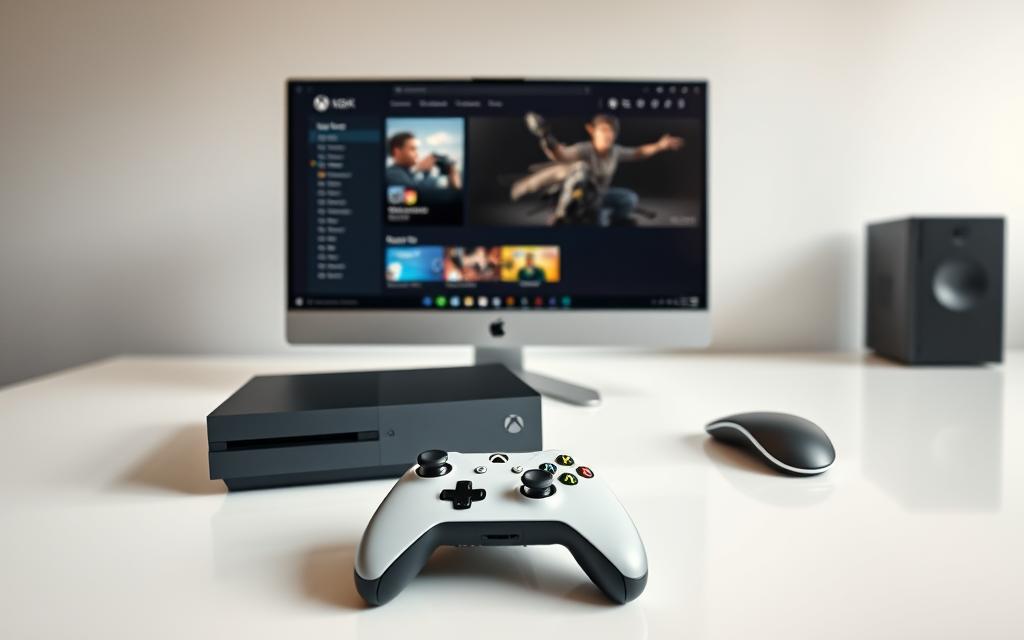
Using the Xbox App for Wireless Play
The Xbox app is a powerful tool for wireless gaming. Available on Windows devices, it allows you to stream games directly from your console. To get started, download the app from the Microsoft Store and sign in with your Xbox Live account.
Ensure your network meets the minimum requirements. A 5GHz Wi-Fi connection is recommended for stable performance. Once set up, you can access your game library, manage your device, and even chat with friends—all from your PC.
- Local vs Cloud Streaming: Local streaming offers lower latency, while cloud gaming provides access to a broader library.
- Port Forwarding: Configure your router to prioritize gaming traffic for smoother performance.
- Bandwidth Consumption: Streaming at 1080p consumes approximately 10-15 Mbps, so monitor your data usage.
Leveraging Remote Play Features
Remote play extends your gaming capabilities beyond your living room. With this feature, you can access your Xbox from any Windows device within your home network. This is ideal for gamers who want to play in different rooms or on the go.
To enable remote play, navigate to the options menu in the Xbox app. Ensure your console is set to instant-on mode for quick access. For the best experience, use an Ethernet-over-USB solution to reduce latency and improve stability.
“Remote play transforms your PC into a portable gaming hub, offering unparalleled convenience.”
If you encounter streaming artifacts or lag, troubleshoot by updating your app and checking your network settings. For mobile setups, consider using a mobile hotspot with sufficient data limits.
Choosing the Right HDMI Cable for Gaming
The right HDMI cable can make or break your gaming setup. Whether you’re playing on a high-end gaming monitor or a standard display, the quality of your cable directly impacts performance. From resolution to refresh rates, every detail matters for an immersive experience.
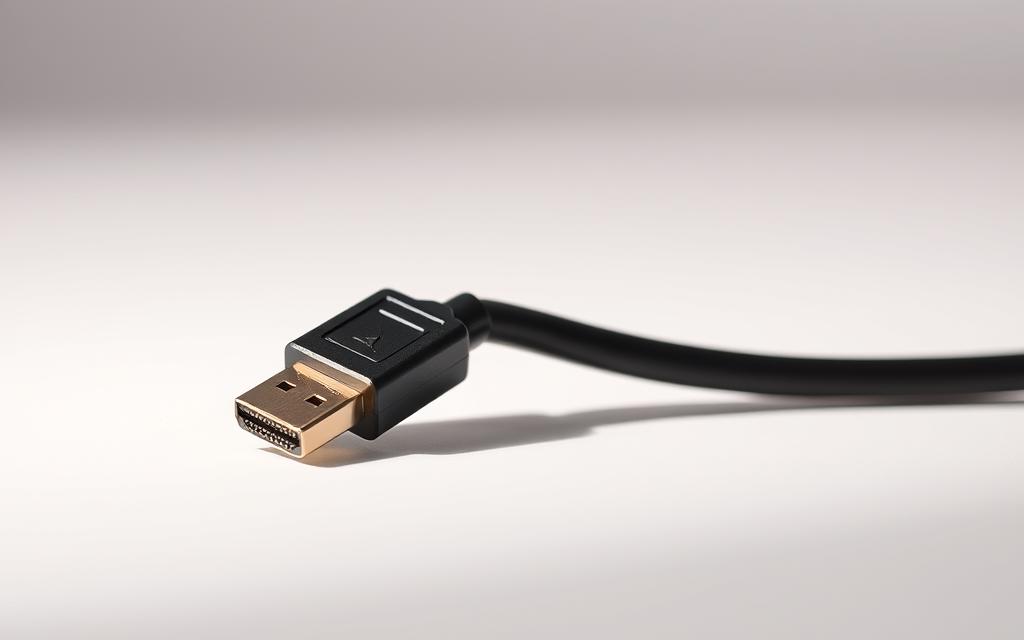
High-Speed vs. Standard HDMI Cables
Not all HDMI cables are created equal. High-speed options, like HDMI 2.1, support up to 48Gbps bandwidth. This enables 4K resolution at 120Hz, perfect for competitive gaming. Standard cables, on the other hand, may struggle with higher resolutions, leading to lag or visual artifacts.
When selecting a cable, look for certification logos like Ultra High Speed. These ensure compatibility with the latest features, such as Variable Refresh Rate (VRR) and Auto Low Latency Mode (ALLM).
Recommended Cable Lengths
Cable length plays a crucial role in signal quality. For 4K gaming, the maximum recommended length is 25 feet. Beyond this, signal degradation can occur, affecting image clarity. Active cables with built-in boosters are ideal for longer distances, while passive cables work well for shorter runs.
Braided construction offers better durability and shielding against interference. Angled connectors provide a secure fit, reducing accidental disconnections during intense gaming sessions.
- Certification Tiers: Ultra High Speed ensures compatibility with HDMI 2.1 features.
- Bandwidth vs. Resolution: Higher bandwidth supports sharper visuals and smoother motion.
- Active vs. Passive Cables: Active cables include signal boosters for longer distances.
- Counterfeit Certifications: Verify official HDMI Licensing Administrator logos to avoid fakes.
“Investing in a high-quality HDMI cable ensures your gaming setup performs at its best, delivering stunning visuals and minimal lag.”
For more insights on selecting the perfect HDMI cable, check out this comprehensive HDMI cable buying guide.
Common Issues and How to Fix Them
Even the best setups can encounter occasional hiccups. Whether it’s a missing signal or audio problems, knowing how to troubleshoot can save your gaming session. Below, we’ll address two common issues and provide practical tips to resolve them.
No Signal Detected on Laptop
If your laptop isn’t detecting the signal, start by checking the device connections. Ensure the HDMI cable is securely plugged into both the Xbox and the laptop. A loose connection is often the culprit.
Next, verify compatibility between your devices. Some laptops lack HDMI input ports, requiring an adapter. If the issue persists, try these steps:
- Update your laptop’s display drivers to the latest version.
- Check for HDCP compliance, as incompatible devices can cause handshake issues.
- Test with a different HDMI cable or port to rule out hardware problems.
For advanced users, an EDID emulator can resolve handshake problems by mimicking display data. Manual EDID override is another option, though it requires technical expertise.
Audio Not Working Through HDMI
Audio problems can be frustrating, especially when the video works fine. Start by checking the Xbox audio output settings. Navigate to Profile & System > Settings > General > Volume & Audio Output.
Ensure the audio format matches your device capabilities. For example, Dolby Digital may not work with all setups, so switch to PCM if needed. On your laptop, verify the audio output source:
- Right-click the volume icon in the taskbar.
- Select Sounds and go to the Playback tab.
- Set the HDMI output as the default device.
“Proper audio configuration ensures immersive gameplay, making every sound detail count.”
If the issue persists, inspect the HDMI cable for damage or try a different one. Updating the HDMI controller drivers can also resolve audio issues.
Maximizing Performance for Smooth Gameplay
Achieving peak performance in gaming requires more than just hardware; it’s about optimizing every aspect of your system. From updating drivers to managing background processes, these tweaks can significantly enhance your gaming experience.
Updating Graphics Drivers
Graphics drivers are the backbone of your gaming sessions. Outdated drivers can lead to stuttering, crashes, and reduced performance. Always opt for OEM drivers over generic ones, as they are tailored for your specific hardware.
For a clean installation, use tools like Display Driver Uninstaller (DDU) to remove old drivers completely. Then, download the latest version from the manufacturer’s website. Stable drivers are recommended for most users, while beta drivers are ideal for early adopters seeking cutting-edge features.
- MSI Afterburner: Monitor GPU performance and adjust settings for optimal results.
- Windows Game Bar: Use this built-in tool to track frame rates and system performance.
- Driver Rollback: If issues arise, revert to a previous stable version.
Disabling Background Apps on Your Laptop
Background apps can consume valuable resources, slowing down your gaming experience. Start by managing startup apps through the Task Manager. Disable unnecessary programs to free up CPU and memory.
Optimize your Windows power plan by selecting the “High Performance” option. This ensures your system prioritizes gaming over energy efficiency. Additionally, configure your antivirus to enter gaming mode, reducing interruptions during play.
“A well-optimized system ensures smoother gameplay and fewer distractions, allowing you to focus on the action.”
For advanced users, consider adjusting the page file size and prioritizing background services. These tweaks can further enhance performance, especially on systems with limited RAM.
Conclusion
Setting up your gaming devices correctly ensures a smooth and enjoyable experience. Recap the key steps to establish a reliable connection. Always use high-quality components like HDMI cables for optimal performance. This minimizes lag and enhances your gaming experience.
Regular system maintenance is crucial. Update drivers and disable background apps to keep your laptop running efficiently. Troubleshooting fundamentals can resolve common issues quickly. For example, check cable connections and ensure proper input settings.
Future-proof your setup by choosing compatible hardware. Compare wired and wireless alternatives to find the best fit for your needs. Engage with community support resources for additional tips and solutions.
Finally, optimize your system for peak performance. Adjust display settings and enable features like Game Mode. For more insights, check this guide on HDMI setups. These steps ensure a seamless and immersive gaming experience.
FAQ
What hardware is required to connect an Xbox to a PC using HDMI?
You’ll need an HDMI cable, an HDMI output port on your Xbox, and an HDMI input port on your laptop or monitor. Ensure both devices support HDMI connectivity.
How do I check if my laptop is compatible for this setup?
Verify if your laptop has an HDMI input port. Most laptops have HDMI output ports, so compatibility depends on having an HDMI input for this specific use case.
What steps are involved in connecting the devices?
Power off both devices, connect the HDMI cable from the Xbox output port to the laptop input port, and configure the display settings on your laptop to detect the Xbox.
How can I optimize the display settings for gaming?
Set the correct resolution and refresh rate in the Xbox display settings. Enable Game Mode on your laptop to reduce input lag and enhance performance.
What should I do if my laptop doesn’t detect the Xbox?
Ensure the HDMI cable is securely connected. Switch the input source on your laptop to HDMI and check for any display detection issues in the settings.
Can I use my laptop as a monitor for Xbox gaming?
Yes, if your laptop has an HDMI input port, you can use it as a monitor by connecting the Xbox and switching the input source to HDMI.
Are there wireless alternatives to HDMI connections?
Yes, you can use the Xbox app or Remote Play features to stream your Xbox to your PC wirelessly, though this may introduce some latency.
What type of HDMI cable is best for gaming?
High-speed HDMI cables are recommended for gaming as they support higher resolutions and refresh rates, ensuring a smoother gaming experience.
What should I do if there’s no signal detected on my laptop?
Check the HDMI cable for damage, ensure both devices are powered on, and verify that the correct input source is selected on your laptop.
How can I improve audio quality during gaming sessions?
Use external speakers or headphones connected to your laptop or Xbox. Ensure the audio settings are configured correctly in both devices.
How do I reduce input lag for competitive gaming?
Enable Game Mode on your laptop, use a high-speed HDMI cable, and close background apps to minimize latency during gaming sessions.
Should I update my graphics drivers for better performance?
Yes, updating your laptop’s graphics drivers can improve compatibility and performance when using it as a monitor for your Xbox.


